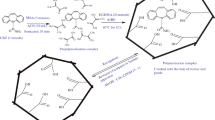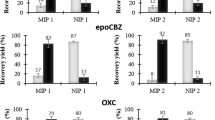Abstract
A molecularly imprinted polymer (MIP) was designed in order to allow the selective solid-phase extraction of carbamazepine (CBZ), an anticonvulsant and mood-stabilizing drug, at ultra-trace level from aqueous environmental samples. A structural analog of CBZ was selected as a dummy template and different synthesis conditions were screened. The selectivity of the resulting imprinted polymers was evaluated by studying the retention of CBZ in a solvent similar to the one used for the synthesis. The presence of imprinted cavities in the polymers was then demonstrated by comparing the elution profiles (obtained by using MIP and a non-imprinted polymer, NIP, as a control) of the template, of CBZ, and of a structural analog of CBZ. Then, the extraction procedure was further optimized for the treatment of aqueous samples on the two most promising MIPs, with special attention being paid to the volume and composition of the percolation and washing solutions. The best MIP provided a highly selective retention in tap water with 81% extraction recovery for CBZ in the elution fraction of the MIP and only 14% for NIP. The repeatability of the extraction procedure was demonstrated for both tap and river waters (RSD below 4% in river water) for the drugs CBZ, oxcarbamazepine, and one metabolite (carbamazepine 10,11-epoxide). A MIP capacity of 1.15 μmol g−1 was determined. Finally, an analytical procedure involving the MIP was developed allowing the detection of CBZ at a concentration level of only a few nanograms per liter in river water. The selectivity provided by the MIP resulted in a 3000-fold increase of the signal-to-noise ratio in LC/MS analysis as compared to the use of conventional sorbent.

Graphical abstract





Similar content being viewed by others
References
Heberer T, Feldmann D. Contribution of effluents from hospitals and private households to the total loads of diclofenac and carbamazepine in municipal sewage effluents--modeling versus measurements. J Hazard Mater. 2005;122:211–8. https://doi.org/10.1016/j.jhazmat.2005.03.007.
Ferrer I, Thurman EM. Analysis of 100 pharmaceuticals and their degradates in water samples by liquid chromatography/quadrupole time-of-flight mass spectrometry. J Chromatogr A. 2012;1259:148–57. https://doi.org/10.1016/j.chroma.2012.03.059.
Luo Y, Guo W, Ngo HH, Nghiem LD, Hai FI, Zhang J, et al. A review on the occurrence of micropollutants in the aquatic environment and their fate and removal during wastewater treatment. Sci Total Environ. 2014;473–474:619–41. https://doi.org/10.1016/j.scitotenv.2013.12.065.
Wick A, Fink G, Joss A, Siegrist H, Ternes TA. Fate of beta blockers and psycho-active drugs in conventional wastewater treatment. Water Res. 2009;43:1060–74. https://doi.org/10.1016/j.watres.2008.11.031.
Alvarino T, Suarez S, Lema JM, Omil F. Understanding the removal mechanisms of PPCPs and the influence of main technological parameters in anaerobic UASB and aerobic CAS reactors. J Hazard Mater. 2014;278:506–13. https://doi.org/10.1016/j.jhazmat.2014.06.031.
Hai FI, Yang S, Asif MB, Sencadas V, Shawkat S, Sanderson-Smith M, et al. Carbamazepine as a possible anthropogenic marker in water: occurrences, toxicological effects, regulations and removal by wastewater treatment technologies. Water. 2018;10:107. https://doi.org/10.3390/w10020107.
Jos A, Repetto G, Rios JC, Hazen MJ, Molero ML, del Peso A, et al. Ecotoxicological evaluation of carbamazepine using six different model systems with eighteen endpoints. Toxicol Vitro Int J Publ Assoc BIBRA. 2003;17:525–32.
Huerta B, Jakimska A, Gros M, Rodríguez-Mozaz S, Barceló D. Analysis of multi-class pharmaceuticals in fish tissues by ultra-high-performance liquid chromatography tandem mass spectrometry. J Chromatogr A. 2013;1288:63–72. https://doi.org/10.1016/j.chroma.2013.03.001.
Lin Y-Y, Wang C-C, Ho Y-H, Chen C-S, Wu S-M. Analysis of carbamazepine and its five metabolites in serum by large-volume sample stacking-sweeping capillary electrophoresis. Anal Bioanal Chem. 2013;405:259–66. https://doi.org/10.1007/s00216-012-6481-x.
Durán-Alvarez JC, Becerril-Bravo E, Castro VS, Jiménez B, Gibson R. The analysis of a group of acidic pharmaceuticals, carbamazepine, and potential endocrine disrupting compounds in wastewater irrigated soils by gas chromatography-mass spectrometry. Talanta. 2009;78:1159–66. https://doi.org/10.1016/j.talanta.2009.01.035.
Wad N. Simultaneous determination of eleven antiepileptic compounds in serum by high-performance liquid chromatography. J Chromatogr. 1984;305:127–33.
Gómez MJ, Petrović M, Fernández-Alba AR, Barceló D. Determination of pharmaceuticals of various therapeutic classes by solid-phase extraction and liquid chromatography-tandem mass spectrometry analysis in hospital effluent wastewaters. J Chromatogr A. 2006;1114:224–33. https://doi.org/10.1016/j.chroma.2006.02.038.
Franceschi L, Furlanut M. A simple method to monitor plasma concentrations of oxcarbazepine, carbamazepine, their main metabolites and lamotrigine in epileptic patients. Pharmacol Res. 2005;51:297–302. https://doi.org/10.1016/j.phrs.2004.09.008.
Lajeunesse A, Vernouillet G, Eullaffroy P, Gagnon C, Juneau P, Sauvé S. Determination of carbamazepine in aquatic organisms by liquid-liquid extraction and liquid chromatography-tandem mass spectrometry. J Environ Monit. 2009;11:723–5. https://doi.org/10.1039/b820302b.
Beltran A, Caro E, Marcé RM, Cormack PA, Sherrington DC, Borrull F. Synthesis and application of a carbamazepine-imprinted polymer for solid-phase extraction from urine and wastewater. Anal Chim Acta. 2007;597:6–11. https://doi.org/10.1016/j.aca.2007.06.040.
Beltran A, Marcé RM, Cormack PA, Borrull F. Synthesis by precipitation polymerisation of molecularly imprinted polymer microspheres for the selective extraction of carbamazepine and oxcarbazepine from human urine. J Chromatogr A. 2009;1216:2248–53. https://doi.org/10.1016/j.chroma.2009.01.024.
Dai C, Geissen S-U, Zhang Y, Zhang Y, Zhou X. Performance evaluation and application of molecularly imprinted polymer for separation of carbamazepine in aqueous solution. J Hazard Mater. 2010;184:156–63. https://doi.org/10.1016/j.jhazmat.2010.08.018.
Esfandyari-Manesh M, Javanbakht M, Atyabi F, Badiei A, Dinarvand R. Effect of porogenic solvent on the morphology, recognition and release properties of carbamazepine-molecularly imprinted polymer nanospheres. J Appl Polym Sci. 2011;121:1118–26. https://doi.org/10.1002/app.33812.
Esfandyari-Manesh M, Javanbakht M, Atyabi F, Dinarvand R. Synthesis and evaluation of uniformly sized carbamazepine-imprinted microspheres and nanospheres prepared with different mole ratios of methacrylic acid to methyl methacrylate for analytical and biomedical applications. J Appl Polym Sci. 2012;125:1804–13. https://doi.org/10.1002/app.36288.
Esfandyari-Manesh M, Javanbakht M, Dinarvand R, Atyabi F. Molecularly imprinted nanoparticles prepared by miniemulsion polymerization as selective receptors and new carriers for the sustained release of carbamazepine. J Mater Sci Mater Med. 2012;23:963–72. https://doi.org/10.1007/s10856-012-4565-y.
Dai C, Zhang J, Zhang Y, Zhou X, Duan Y, Liu S. Removal of carbamazepine and clofibric acid from water using double templates-molecularly imprinted polymers. Environ Sci Pollut Res Int. 2013;20:5492–501. https://doi.org/10.1007/s11356-013-1565-5.
Lee J-C, Kim C-R, Byun H-S. Synthesis and adsorption properties of carbamazepine imprinted polymer by dispersion polymerization in supercritical carbon dioxide. Korean J Chem Eng. 2014;31:2266–73. https://doi.org/10.1007/s11814-014-0178-0.
Khalilian F, Ahmadian S. Molecularly imprinted polymer on a SiO2 -coated graphene oxide surface for the fast and selective dispersive solid-phase extraction of Carbamazepine from biological samples. J Sep Sci. 2016;39:1500–8. https://doi.org/10.1002/jssc.201501392.
Zhang Y-L, Zhang J, Dai C-M, Zhou X-F, Liu S-G. Sorption of carbamazepine from water by magnetic molecularly imprinted polymers based on chitosan-Fe3O4. Carbohydr Polym. 2013;97:809–16. https://doi.org/10.1016/j.carbpol.2013.05.072.
Pichon V. Selective sample treatment using molecularly imprinted polymers. J Chromatogr A. 2007;1152:41–53. https://doi.org/10.1016/j.chroma.2007.02.109.
Chapuis F, Pichon V, Lanza F, Sellergren S, Hennion M-C. Optimization of the class-selective extraction of triazines from aqueous samples using a molecularly imprinted polymer by a comprehensive approach of the retention mechanism. J Chromatogr A. 2003;999:23–33. https://doi.org/10.1016/S0021-9673(03)00552-1.
Chapuis-Hugon F, Cruz-Vera M, Savane R, Ali WH, Valcarcel M, Deveaux M, et al. Selective sample pretreatment by molecularly imprinted polymer for the determination of LSD in biological fluids. J Sep Sci. 2009;32:3301–9. https://doi.org/10.1002/jssc.200900247.
Lasáková M, Thiébaut D, Jandera P, Pichon V. Molecularly imprinted polymer for solid-phase extraction of ephedrine and analogs from human plasma. J Sep Sci. 2009;32:1036–42. https://doi.org/10.1002/jssc.200800684.
Duy SV, Lefebvre-Tournier I, Pichon V, Hugon-Chapuis F, Puy J-Y, Périgaud C. Molecularly imprinted polymer for analysis of zidovudine and stavudine in human serum by liquid chromatography-mass spectrometry. J Chromatogr B Analyt Technol Biomed Life Sci. 2009;877:1101–8. https://doi.org/10.1016/j.jchromb.2009.02.068.
Thibert V, Legeay P, Chapuis-Hugon F, Pichon V. Synthesis and characterization of molecularly imprinted polymers for the selective extraction of cocaine and its metabolite benzoylecgonine from hair extract before LC-MS analysis. Talanta. 2012;88:412–9. https://doi.org/10.1016/j.talanta.2011.11.009.
Boulanouar S, Combès A, Mezzache S, Pichon V. Synthesis and application of molecularly imprinted polymers for the selective extraction of organophosphorus pesticides from vegetable oils. J Chromatogr A. 2017;1513:59–68. https://doi.org/10.1016/j.chroma.2017.07.067.
Ollers S, Singer HP, Fässler P, Müller SR. Simultaneous quantification of neutral and acidic pharmaceuticals and pesticides at the low-ng/l level in surface and waste water. J Chromatogr A. 2001;911:225–34.
Yang W, Hu Y, Chen Z, Jiang X, Wang J, Wang R. Solubility of itaconic acid in different organic solvents: experimental measurement and thermodynamic modeling. Fluid Phase Equilib. 2012;314:180–4. https://doi.org/10.1016/j.fluid.2011.09.027.
Acknowledgments
This work was supported by the French National Research Agency (ANR Program: ANR-15-CE04-0012, project MIP_WQT).
Author information
Authors and Affiliations
Corresponding author
Ethics declarations
This is not a clinical study on humans/animals.
Conflict of interest
The authors declare that they have no conflict of interest.
Additional information
Publisher’s note
Springer Nature remains neutral with regard to jurisdictional claims in published maps and institutional affiliations.
Electronic supplementary material
ESM 1
(PDF 105 kb)
Rights and permissions
About this article
Cite this article
Kadhirvel, P., Combès, A., Bordron, L. et al. Development and application of water-compatible molecularly imprinted polymers for the selective extraction of carbamazepine from environmental waters. Anal Bioanal Chem 411, 1525–1536 (2019). https://doi.org/10.1007/s00216-019-01586-8
Received:
Revised:
Accepted:
Published:
Issue Date:
DOI: https://doi.org/10.1007/s00216-019-01586-8




